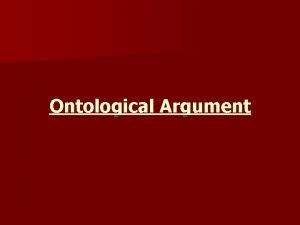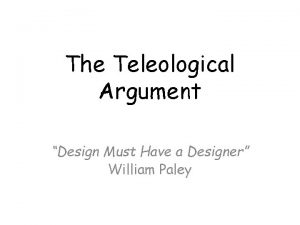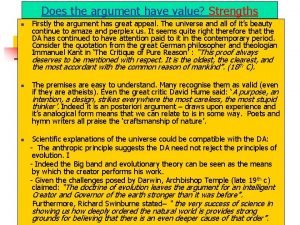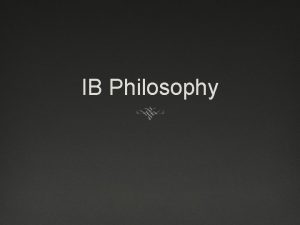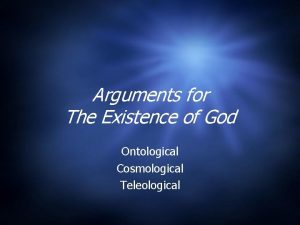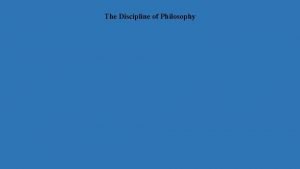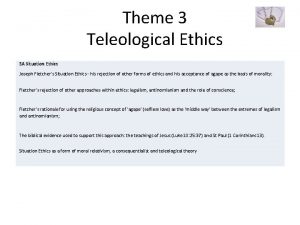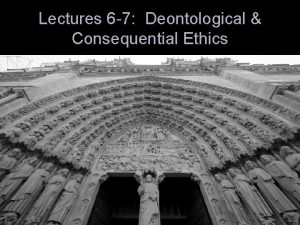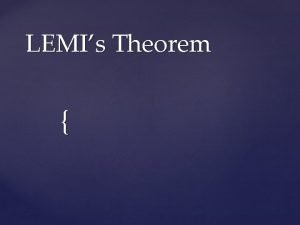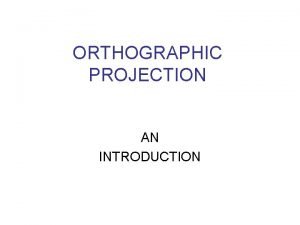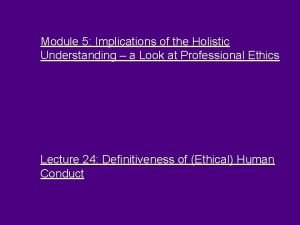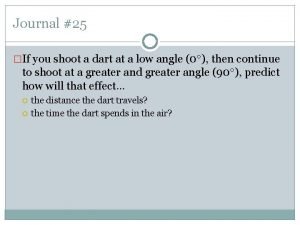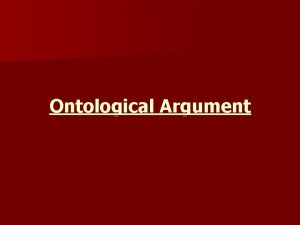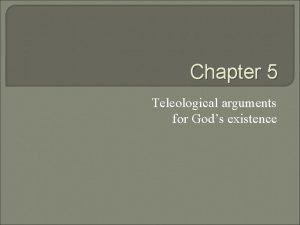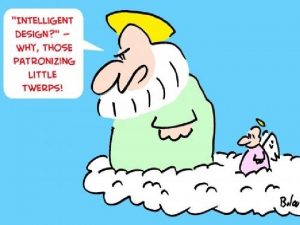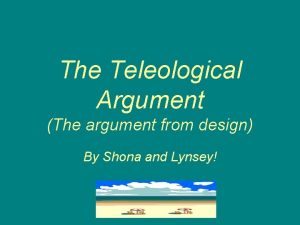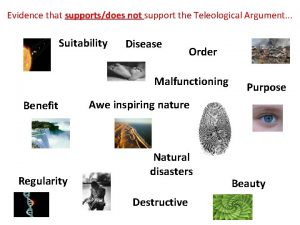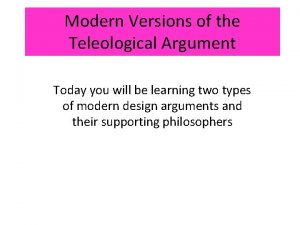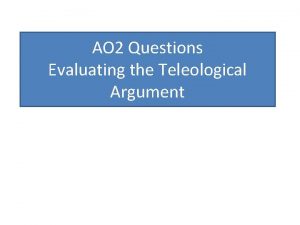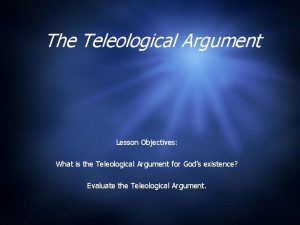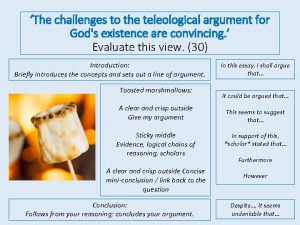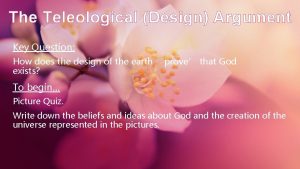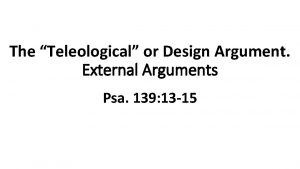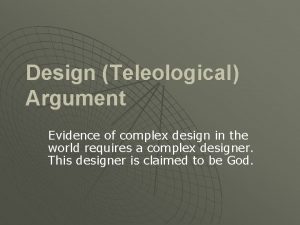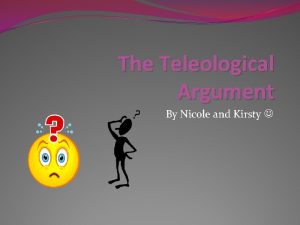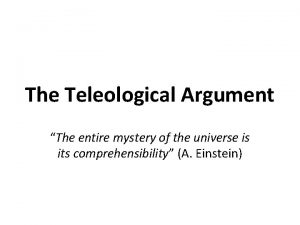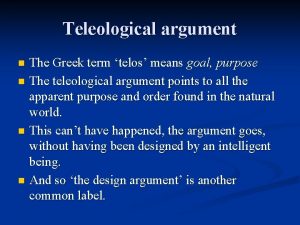The Teleological Argument Also known as The argument


















- Slides: 18

The Teleological Argument Also known as “The argument from design”

Key terms • Read the words and discuss what you think they might mean before revealing the definition

Aquinas: The fifth way The argument from design finds its origins in Aquinas’ Summa Theologica and is the fifth of his five ways of proving the existence of God. Aquinas’ argument can be explained as follows: “The fifth way is taken from the governance of the world. We see that things which lack knowledge, such as natural bodies, act for an end, and this is evident from their acting always, or nearly always, in the same way, so as to obtain the best result. Hence it is plain that they achieve their end, not fortuitously, but designedly. Now whatever lacks knowledge cannot move towards an end, unless it be directed by some being endowed with knowledge and intelligence; as the arrow is directed by the archer. Therefore some intelligent being exists by whom all natural things are directed to their end; and this being we call God. ”

Aquinas: The fifth way Aquinas argued from design qua regularity. He saw the overall order in the world as proof of a designer: ‘this being we call God. ’ Aquinas stated that everything works together to achieve order, despite the fact that inanimate objects have no mind or rational powers to achieve this.

Aquinas: The fifth way Aquinas explained his point by using the example of an arrow, saying that for an arrow to reach its destination (telos) it must be directed first of all by the archer. In the same way, ‘natural bodies’ seem to act in a regular fashion to reach a specific purpose. As they, like the arrow, are not able to direct themselves, there must be a God doing the directing.

William Paley’s argument from design William Paley (1743 -1805), in his book Natural Theology, made the argument that the complexity & efficiency of natural objects (e. g. . the eye, the brain, etc. ) are evidence that they must have been purposefully designed. How else could they have come to be as they are – perfectly adapted for the purpose they serve? A watch has complex mechanisms, This watch is designed by a being of intelligence not by random chance. The Universe is complex and therefore infers a designer.

Tennant anthropic and aesthetic principles • Anthropic Principle: The natural world, things that are necessary for life to be sustained. Evolution/Natural Selection has development of intelligent human life.

Tennant aesthetic argument Aesthetic argument: Natural appreciation human beings have for things that are considered to be beautiful. This can be extended to Nature, Poetry, Art. As Humans we operate the survival of he fittest so why do human beings appreciate beauty? Tennant argued this is a result of a benevolent God, God wants us to live and enjoy the world we live in.

For and Against • Read the statements and then decide whether they are for or against the teleological argument by dragging them to a side of the scale.

Criticisms of Paley’s design argument A number of criticisms of the design argument have been put forward, notably by the famous British philosopher David Hume (1711 -1776): 1. The analogy employed by Paley is weak – it assumes without justification that there is a significant resemblance between objects which occur naturally (eg. the eye) and those which have been designed by humans (eg. a watch). Is there a strong similarity between the two sufficient to make the analogy strong? Hume argued that we cannot infer from the fact that examples of order in our universe have human causes (e. g. the watch) that the universe as a whole has a cause & has been designed, because the universe is unique. Therefore, because the universe is unique, we cannot rely on analogy to explain it.

2. If the world/universe was designed, who designed the designer? This point takes us to a similar debate we saw with the cosmological argument. We can either accept the existence of God as the cause of the universe, and then accept God’s existence as necessary (ie. always existing); or, we could just stop at the universe and accept it’s existence as necessary (always in existence) without positing God to explain it. 3. The argument of design tells us little about God except God is a design-producing being (albeit an extremely powerful one!). The argument doesn’t allow us to draw any conclusions as to God’s nature or character beyond that. The design argument doesn’t prove the existence of only one God, as there may be multiple designers.

4. The scientific theory of evolution (discovered by Charles Darwin 1809 -82) now provides us with an explanation of how complex life develops without the need for a ‘designer’. Darwin showed how, by a process of survival of the fittest, over millions of years, those animal & plant species best suited to their environments live to pass on their characteristics to their offspring, whilst less well suited species perish. This process explains how such marvelous adaptations to environments as are found in the plant & animal kingdom have occurred, without needing to introduce the notion of God. Do you agree ?

Three forms of the argument • Read these views and then discuss the following: • In what ways are the views of Aquinas, Paley and Tennant (i) similar and (ii) different? • Which is the most convincing and why?

Challenges to the argument Hume and Darwin

Whether cosmological arguments for God’s existence are persuasive in the 21 st Century. • Fits in with scientific theories such as the big bang. • There is posteriori observation. • Craig’s Kalam demonstrates universe result of a deliberate choice, personal creator. • Based on cause and effect arguments which should be not discounted. • Newton First Law of Motion , nothing can move unless its moved.

The effectiveness of the teleological argument for God’s existence Plato spoke of a craftsmen this laid foundations Judeo. Christian thought. Based on posteriori , inductive observer. Paley’s analogy points out that universe is not result of chance but an intelligent designer. The contribution of Tennant, an intelligent designer has made the world for intelligent human life. • The use of analogy is not adequate to compare complexities of the universe to a watch. Is there a timeline? More than one designer? • Arrogant claims that we can assume the cause of the complexities of the universe. How about Science and Dawkins claims?

Key terms • Match up the key terms and definitions

Test yourself
 Ontological vs teleological
Ontological vs teleological The teleological argument
The teleological argument Is the teleological argument inductive or deductive
Is the teleological argument inductive or deductive Teleological argument strengths and weaknesses
Teleological argument strengths and weaknesses Teleological argument
Teleological argument Teleological
Teleological Ontological cosmological teleological
Ontological cosmological teleological Teleological synonym
Teleological synonym Is situation ethics teleological
Is situation ethics teleological Teleological
Teleological Maxim definition
Maxim definition Principles of categorical imperative
Principles of categorical imperative Formalism ethics
Formalism ethics Teleological ethics vs deontological ethics
Teleological ethics vs deontological ethics Lamis theorem formula
Lamis theorem formula Orthographic projection of circle
Orthographic projection of circle Holistic understanding of harmony on professional ethics
Holistic understanding of harmony on professional ethics Path taken by a projectile is known as
Path taken by a projectile is known as Dle stx
Dle stx
